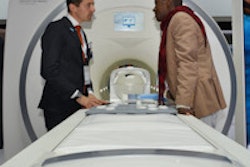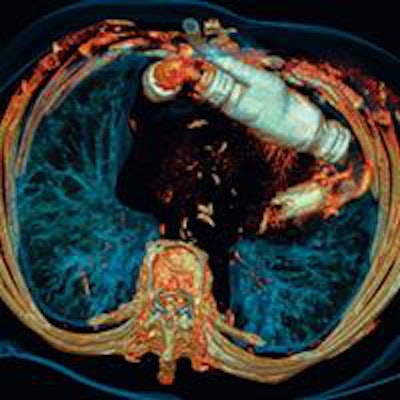
Siemens Healthcare plans to launch an updated version of its Somatom Definition Edge single-source CT scanner at the upcoming RSNA 2014 meeting in Chicago. Edge features new x-ray tube technology that Siemens believes will make dual-energy imaging accessible at the lower price points possible with a single-source scanner.
Siemens launched the initial version of Edge three years ago at RSNA 2011 as a single-source version of the company's flagship dual-source Somatom Flash CT scanner. Siemens was able to set a 30% to 40% lower list price for Edge than Flash by dispensing with the top-of-the-line scanner's second set of x-ray tubes and detectors.
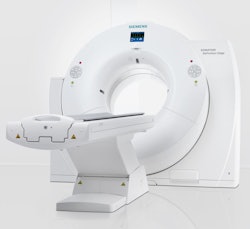 Siemens' Definition Edge single-source CT scanner.
Siemens' Definition Edge single-source CT scanner.The dual-source design has been particularly adept at performing dual-energy studies, in which scans are performed at two different energy levels; the resulting data offer details on tissue composition that go beyond morphology. Dual-energy imaging is becoming increasingly common for a variety of clinical applications, and dual-source systems can acquire both sets of energy data simultaneously.
In 2011, Siemens promoted Edge as being capable of performing dual-energy studies. But there are drawbacks to performing dual-energy studies using single-source CT techniques such as fast kV switching or dual-layer detectors, primarily because the x-ray spectra are not emitted simultaneously as they are on a dual-source scanner.
For the new version of Edge, Siemens developed a new technology designed to improve single-source dual-energy imaging. Called TwinBeam Dual Energy, the technique enables the company's Straton tube to split the x-ray beam into two parts: one can be hardened to create a beam that has a higher energy level, while the second part of the beam has a lower energy level, according to Jan Freund, director of global CT product marketing.
Making dual-energy imaging available on a less-expensive scanner like Edge creates the potential for the technique to become far more clinically useful as it expands to sites that can't afford a dual-source scanner, Freund said.
"With the capability to have dual-energy in machines like Edge, it has a much larger potential in terms of accessibility in the clinical world," he told AuntMinnie.com.
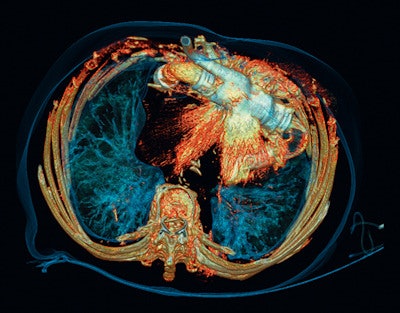 Follow-up study after a cardiac pump implantation. The two volume-rendered images show that the severe artifacts caused by the implanted pump (above) are significantly reduced by the iMAR reconstruction technique, and the surrounding anatomical structures can be clearly visualized (below). Copyright: University Erlangen-Nuremberg, Erlangen, Germany.
Follow-up study after a cardiac pump implantation. The two volume-rendered images show that the severe artifacts caused by the implanted pump (above) are significantly reduced by the iMAR reconstruction technique, and the surrounding anatomical structures can be clearly visualized (below). Copyright: University Erlangen-Nuremberg, Erlangen, Germany.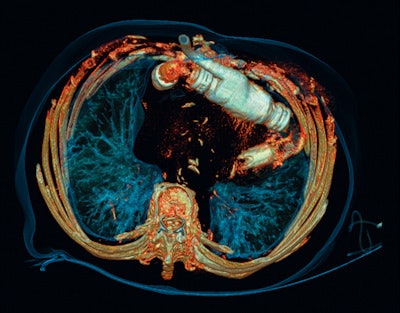
Clinical applications for dual-energy imaging include tumor analysis and lesion characterization, such as in abdominal scans for liver lesions. It's also useful for emergency imaging, such as evaluating pulmonary embolism, or in vascular scans by removing bone to provide a clearer picture, Freund said.
In addition to dual-energy imaging, Siemens had added two other technologies to Definition Edge: a new version of its iterative reconstruction technology and a metal artifact reduction algorithm.
For iterative reconstruction, Siemens has adapted for Definition Edge its high-end advanced modeled iterative reconstruction (ADMIRE) algorithm, previously found only on the Force scanner. ADMIRE is being made available for all Siemens scanners that use the company's Stellar detectors.
With respect to metal artifacts, the company has developed iterative metal artifact reduction (iMAR), which uses an iterative approach of looping back to raw data to compensate for metal artifacts. iMAR can be used throughout the body and can be performed with dual-energy acquisition.
Siemens is in the process of applying for 510(k) clearance for the new version of Definition Edge, and the company hopes to begin shipping the system outside the U.S. in the first quarter of 2015. Siemens will offer the TwinBeam, iMAR, and ADMIRE technologies as upgrades to Definition Edge and AS+ CT scanners installed in the field once regulatory clearances are received.







